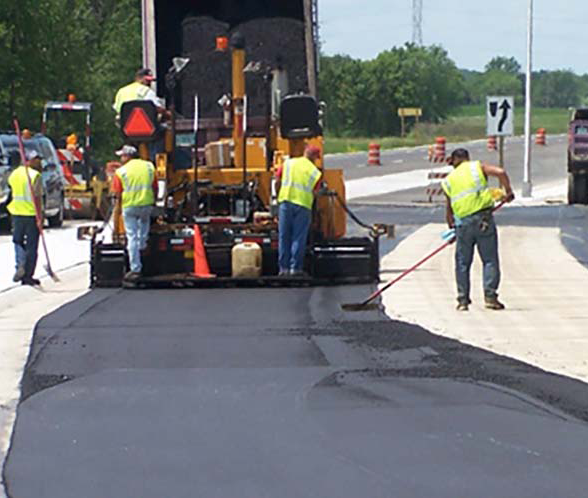Hot Mix Asphalt Paving: Redefining Commercial Residential Or Commercial Property Landscapes
Hot Mix Asphalt Paving: Redefining Commercial Residential Or Commercial Property Landscapes
Blog Article
Unlocking the Tricks of Warm Mix Asphalt Modern Technology
Exploring the depths of hot mix asphalt technology discovers a globe where specific formulations and thorough procedures merge to form our roadways and framework. The blend of binders, accumulations, and fillers isn't simply a building job however a tactical orchestration of toughness and performance. As we peer right into the complex dance of elements, a tapestry of resilience and sustainability unfolds. What exists underneath this surface of asphaltic mastery, and what keys wait to be introduced in the realm of paving innovations?
Importance of Warm Mix Asphalt
Hot Mix Asphalt plays a crucial role in modern-day facilities advancement because of its resilience and cost-effectiveness. As the most commonly utilized leading material for roadways, highways, and parking great deals, Warm Mix Asphalt provides a variety of benefits that add to its importance in building tasks. One essential benefit is its capacity to endure rush hour tons and rough weather problems, giving a lasting and trustworthy surface area for transportation networks. Furthermore, Hot Mix Asphalt is cost-efficient in both initial building and lasting upkeep, making it a favored selection for many facilities tasks.
The resilience of Hot Mix Asphalt originates from its composition, that includes accumulations, binder, and filler products that are meticulously picked and mixed to meet specific performance requirements. This accurate combination results in a strong and flexible pavement that can endure frequent usage without significant wear and tear. Moreover, Hot Mix Asphalt is 100% recyclable, further enhancing its sustainability and environmental benefits. On the whole, the relevance of Warm Mix Asphalt in facilities development can not be understated, as it continues to be a cornerstone of modern construction practices.
Parts of Asphalt Mixes
The composition of asphalt blends consists of meticulously selected aggregates, binder, and filler materials that are critical for achieving certain efficiency needs. Aggregates are the primary element of asphalt blends, supplying toughness and stability. The binder, generally bitumen or asphalt concrete, holds the aggregates with each other and gives flexibility and sturdiness to the mix.
The mix and percentage of these parts play a substantial duty in determining the quality and performance of the asphalt mix. Engineers thoroughly develop the mix to satisfy certain demands, thinking about aspects like web traffic quantity, climate conditions, and pavement lifespan. Proper selection and balancing of aggregates, binder, and fillers are essential for creating durable, long-lasting asphalt pavements.
Mixing and Manufacturing Strategies
As soon as the accumulations are selected, the binder, commonly asphalt concrete, is included to bind the materials together. The binder's high quality and amount significantly impact the mix's stamina, versatility, and resistance to environmental elements. Additionally, fillers like hydrated lime or Rose city concrete might be integrated to improve particular qualities of the asphalt mix, such as its workability or wetness resistance.
During manufacturing, the accumulations and binder are heated up, normally between 250-325 ° F(121-163 ° C ), to help with mixing and ensure correct coating of the accumulations. The blending process must be detailed to attain a homogeneous mixture that advertises the preferred performance features of the asphalt. Different techniques, such as batch blending or drum mixing, are employed to attain consistent and premium asphalt mixes for building tasks.
Variables Impacting Asphalt Efficiency
Elements influencing asphalt performance include a variety of variables that influence the sturdiness, durability, and general top quality of asphalt webpage sidewalks. One vital aspect is the high quality of products utilized in the asphalt mix. The kind and source of accumulations, the binder quality, and the ingredients all play a significant function in determining the advice performance of the asphalt sidewalk. The gradation of accumulations is crucial as it impacts the mix's resistance, workability, and stability to rutting and breaking.

Design considerations, such as pavement density and water drainage, are important in making sure the lasting efficiency of the asphalt sidewalk. By meticulously considering these designers, variables and contractors can enhance asphalt efficiency and boost the solution life of sidewalks.
Lasting Practices in Asphalt Innovation

Furthermore, the advancement of warm-mix asphalt (WMA) technologies has obtained grip recently. WMA permits the production and positioning of asphalt blends at lower temperature levels contrasted to standard hot-mix asphalt, leading to reduced power usage and greenhouse gas emissions. Furthermore, the usage of porous asphalt mixes can aid reduce stormwater runoff concerns by enabling water to infiltrate via the pavement and into the ground, advertising natural water purification and charge processes. By executing these sustainable methods, the asphalt industry can add to developing a more resistant and ecologically pleasant facilities network.
Conclusion
To conclude, warm mix asphalt technology plays a vital duty in modern facilities advancement because of its durability and cost-effectiveness. By thoroughly balancing elements, utilizing appropriate blending methods, and thinking about different aspects, designers can produce high-grade asphalt mixes that endure rush hour loads and severe weather conditions. Accepting lasting methods, such as utilizing recycled materials and warm-mix innovations, even more improves the environmental friendliness of asphalt technology.
Mixing and manufacturing strategies in warm mix asphalt modern technology include the exact mix and processing of accumulations, binder, and fillers to produce a resilient and high-performance asphalt mix.Factors affecting asphalt efficiency encompass an array of variables that influence the toughness, durability, and overall top quality of asphalt pavements. Sustainable methods in asphalt technology incorporate different initiatives intended at minimizing the environmental influence of asphalt production and paving procedures. By integrating redeemed asphalt pavement (RAP) and recycled asphalt shingles (RAS) right into new asphalt blends, the industry can substantially decrease the intake of raw materials and power, while likewise lowering garbage dump waste.
WMA permits for the production and positioning of asphalt mixes at reduced temperatures contrasted to conventional hot-mix asphalt, resulting in lowered energy usage and greenhouse gas emissions.
Report this page